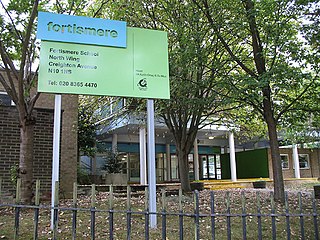
This article needs additional citations for verification . Please help improve this article by adding citations to reliable sources. Unsourced material may be challenged and removed.
Find sources: "Dartford Grammar School for Girls" – news · newspapers · books · scholar · JSTOR ( March 2012 ) ( Learn how and when to remove this template message )
Dartford Grammar School for Girls is a grammar school for girls in Dartford, Kent, England. Formerly known as Dartford County School, the school opened in 1904. It is the sister school of Dartford Grammar School for Boys.
The Dartford County School opened unofficially on 3 October 1904 at a building on Essex Road. The school aimed to provide post-elementary education and to produce additional teachers to teach in new schools. The 75 students were girls aged 8–18; those under 13 were charged six guineas per term, while those 13 and older paid eight guineas per term. The official opening took place on 31 October 1904. During the first term, Amy Brett served as headmistress, overseeing two full-time staff and part-time visiting masters for Art and Singing.
By 1906 enrolment had increased to 113, and two hutted classrooms were built to accommodate the increasing numbers. The faculty had grown to five full-time staff, who taught English language and English literature, Latin, drawing and science, and physical education. In September 1906 the first hockey team was formed. In 1909, the first school magazine was written.
In 1910 there were eight forms and 11 staff. Because of the rapid expansion of the school, school trustees purchased 4 acres (1.6 ha) of land on Shepherds Lane and built a new structure, which cost £8,335. Rather than use the more popular and less expensive red brick favoured by many schools of the time, the school chose to clad the building in Kentish ragstone. The building included an assembly hall (now the canteen), a library, science laboratories, a dining room, and accommodation for the staff. It opened on 31 October 1912.
On 27 June 1913, the school participated in the annual inter-county school sports events for the first time. The following year a compulsory uniform was introduced for students, consisting of a red, green and white tie, cream blouses with Peter Pan collars and for summer a lighter cotton tunic. Hair had to be drawn back and tied with a black ribbon at the top of the head. Blue overalls were worn for science, and white for cookery.
By 1924 the school's student numbers had increased to 300. The building was expanded, adding five classrooms, a botany laboratory, a geography room, and a cloakroom. The assembly hall was enlarged and temporary huts were placed in the school grounds as dining facilities, which remained until 1937.
A scholarship endowment fund was established in 1925 to assist students continuing into higher education. By 1926 the school was listed as one of the top three secondary schools for girls in Kent, along with Bromley High School and Chatham Grammar School. By 1930 the number of pupils had risen to 400. Four years later, Erith Grammar School became an all-boys school and their 73 female students were sent to Dartford County School. Construction began in January 1937 for a new wing. New classrooms were completed by September 1937, and the new hall was finished the following year to replace the huts which had served as canteen and kitchen, though it was not officially opened until 1939.
In the late 1930s 50% of the students were fee-paying, while the others attended for free. The cost at this time was £4 per term. School legend states that during the Second World War teachers would sit on the top of the school buildings to watch for enemy aircraft. If something were spotted then the girls would go to the air raid shelter where lessons were taken and meals were eaten. Between 1939 and 1947, three bombs fell on the school, and between 1940 and 1942 40 girls and two teachers were evacuated to a small village near Exeter.
In June 2017 Dartford Grammar School for Girls converted to academy status. The school is now sponsored by The Areté Trust. [1]
In September 2003, the school adopted a two-year Key Stage 3 programme, under which students can follow a more flexible curriculum over three years. The school is a specialist science school and has a second specialism in Maths and Computing. The school also received the ArtsMark Gold Award recognising its expertise in arts subjects. The school day consists of five one-hour lessons each day.
DGGS is one of Dartford's top performing state schools. [2] [3] In 2009 all students achieved A*-C grades in their GCSEs and the school was placed 11th in the county for A Level results. [4]
In 2021, the school was ranked 5th in the country by The Telegraph in its list of top 100 schools based on GCSE examinations sat in 2019. [5]
The school organises study visits and exchanges to countries including Cambodia, China, France, Germany, the Netherlands and Spain. [6]
There are also several extra-curricular clubs available for students, categorised as creativity, action, and service.
This article's list of alumni may not follow Wikipedia's verifiability policy. Please improve this article by removing names that do not have independent reliable sources showing they merit inclusion in this article AND are alumni, or by incorporating the relevant publications into the body of the article through appropriate citations. ( November 2019 )
| Notes Granted 20 June 1956.. [9] Crest On a wreath Argent and Vert, A pomme, thereon a fess wavy Argent charged with a bar wavy Azure; over all a horse as in the Arms. Escutcheon Vert, in front of a fess wavy Argent charged with two barrulets wavy Azure a horse rampant also argent; on a chief of the last between two open books Proper [edged Or, bound Gules] a pale Murrey charged with a torch Or. |

Fortismere School is an 11–18 mixed, foundation secondary school and sixth form in Muswell Hill, Greater London, England.
Grammar school in Dartford, Kent, England" />
Dartford Grammar School is a selective secondary foundation school for boys in Dartford, Kent, England, which admits girls to its sixth form. All of the students joining the school are considered to be from the top 25% of the ability range, as determined by the 11-Plus examinations. The students come from Dartford, neighbouring towns and villages, and nearby London boroughs, as well as an increasing number of students from Essex. The current roll is 1,203, including 461 in the sixth form. It is the brother school of Dartford Grammar School for Girls.
William Ellis School is a voluntary aided secondary school and sixth form for boys located in Highgate, London, England.
Grammar school in Tonbridge, Kent, England" />
Tonbridge Grammar School is a state grammar school in Tonbridge, Kent, United Kingdom. The school was established in 1905 at the Technical Institute in Avebury Avenue Tonbridge, having only 19 enrolled students. Today, the school is situated in the South of Tonbridge, where there are approximately 1050 students ranging from 11 to 18 years.

Gravesend Grammar School is a selective grammar school with academy status located in Gravesend, Kent, England. The school accepts boys at age 11 through the 11+ exam accepting a cohort of the top 15-20% and boys and girls at 16, based on their GCSE results. The school continues to strive achieving around 100%(5 A*-C including English and Maths) at GCSE level with many students obtaining >9 GCSEs at the end of Year 11.
Tanbridge House School is a coeducational secondary school located in Horsham, West Sussex, England. Its current head master is Mr Sheridan who started in 2022. The school teaches a variety of subjects across the curriculum. In 2012 95.7% of students achieved A*-C grades at GCSE. Of those, 79% achieved 5 A*-C including English and Maths.
Oxted School is a coeducational secondary school and sixth form located in the English town of Oxted, Surrey. It was opened in 1929 as the first mixed grammar school in Surrey and now has over 1900 pupils aged 11–18.
Academy in Dartford, Kent, England" />
Wilmington Academy is a mixed secondary school located in Wilmington, Kent in the United Kingdom. It stands next to the site of Wilmington Hall.

Rochester Grammar School often abbreviated to RGS is a grammar school for the education of girls between the ages of 11 and 18. It has academy status. It is now known as just "Rochester Grammar School" following the introduction of boys into the sixth form.
The Harvey Grammar School is located in Folkestone, Kent, England. It is a grammar school with academy status founded by the family of William Harvey in 1674.

Selston High School is a mixed secondary school that educates students aged 11–16. It is located in Selston, Nottinghamshire, England. The headteacher is Mr David Broomhead.
Dover Grammar School for Girls is a community grammar school for girls, aged between 11 and 16, and a joint sixth-form with boys between the age of 16 and 18, in Dover, England.

The Canterbury Academy is a co-educational 11-19 academy school in Canterbury, Kent, England. It is a specialist Sports College and 15% of its 1081 pupils are selected on musical aptitude. The school was founded as a non-selective secondary modern foundation school before gaining academy status in 2010.
Academy in Aylesford, Kent, England" />
Aylesford School is a mixed-sex school comprising years 7 to 11, plus a Sixth Form for pupils in years 12 and 13. It was formerly known as Aylesford School - Sports College and locally known as Teapot Lane, is a co-educational secondary school in Kent, England. Situated in modern campus buildings in Teapot Lane, the school serves an area to the west of Maidstone.

Diss High School is a secondary school and sixth form with academy status located in Diss, Norfolk, England. The school has approximately 931 pupils from ages 11 to 18.
Skinners' Academy is a school in the Manor House area for boys and girls aged 11–19. The academy opened in 2010 and is supported by the Worshipful Company of Skinners, a London Livery Company. There are currently approximately 900 pupils on roll from Year 7 - Year 11 and over 100 Sixth Form students. More than 60% of the pupils speak English as an additional language and more than 86% of students are from ethnic minority backgrounds.
Academy in Sittingbourne, Kent, England" />
Fulston Manor School is a secondary School with academy status in Sittingbourne, Kent. The head teacher is Mrs Susie Burden. It teaches years 7–13.
Grammar school in Sittingbourne, Kent, England" />
Highsted Grammar School is a state-funded selective secondary school for girls in Sittingbourne, Kent.

Highworth Grammar School is a selective secondary in Ashford, Kent. The school also admits boys to the sixth form. At an Ofsted inspection in June 2013, the school was rated 1 (outstanding) in all categories.

The Charles Dickens School is a co-educational secondary modern school located in Broadstairs in the English county of Kent. The school is named after Charles Dickens, the 19th-century writer and social critic. It is one of six non-selective schools on the Isle of Thanet, physically isolated corner of Kent.
This page is based on this Wikipedia article
Text is available under the CC BY-SA 4.0 license; additional terms may apply.
Images, videos and audio are available under their respective licenses.